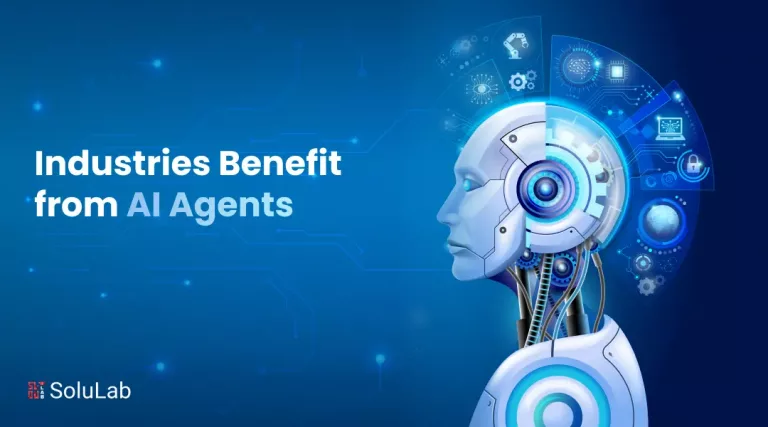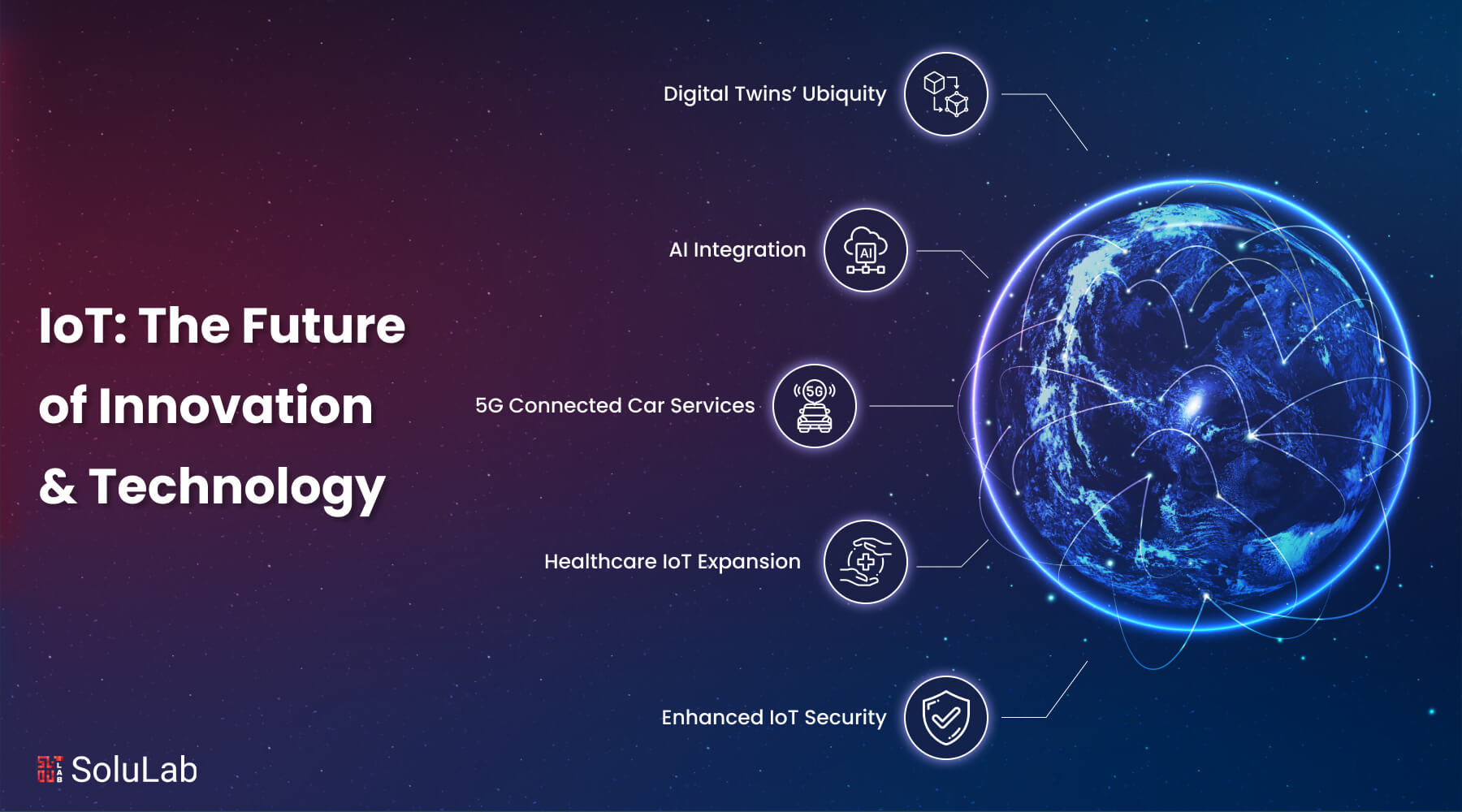
The demand for real-time insights into corporate operations and technological breakthroughs has driven the exponential growth of the Internet of Things. The Internet of Things appears to have a stronger future than it did in 2024, with several trends and forecasts expected to emerge. The potential for IoT appears endless, ranging from developments in artificial intelligence and machine learning to the emergence of smart cities and connected supply chains. In this blog, you will learn about some of the most fascinating advances in IoT technology and their potential implications for humans.
But first, let’s get to know what is Internet of Things in brief!
What is IoT?
The Internet of Things (IoT) is a network of interconnected items such as sensors, electrical equipment, cameras, and so on. They are configured in such a way that IoT automates the linked devices. Smart TVs, refrigerators, and air conditioners are some of the most prevalent IoT gadgets we see and use on a daily basis. To operate these gadgets, we just send them orders via our smartphone application. We also utilize a variety of wearable IoT devices, such as smartwatches and wristbands, to monitor our heart rate, blood pressure, and distance traveled. This is made feasible by intelligently combining technologies and equipment to create an IoT product.
Why Do We Need the Internet of Things (IoT)?
Have you ever gone to the market and missed turning off your air conditioner, fan, or light, leaving you feeling powerless since you couldn’t come home to turn them off? This is where IoT enters the picture. It might alert you of important activities that you frequently neglect to complete. You may also use the mobile app to access your IoT-enabled home appliances from anywhere in the globe.
Another intriguing IoT product is the NFC (near-field communication) smart ring. These rings are a multipurpose gadget. They are rings made up of network connectivity, NFC chips, and sensors that enable data sharing. You can use NFC rings to pay your bills, unlock your car’s door lock with a simple swipe, and get smartphone notifications.
All of this is made feasible by connecting IoT devices to Internet servers, which facilitates data sharing and exchange. This technique eliminates human labor and saves a significant amount of time.
How Does the Internet of Things Work?
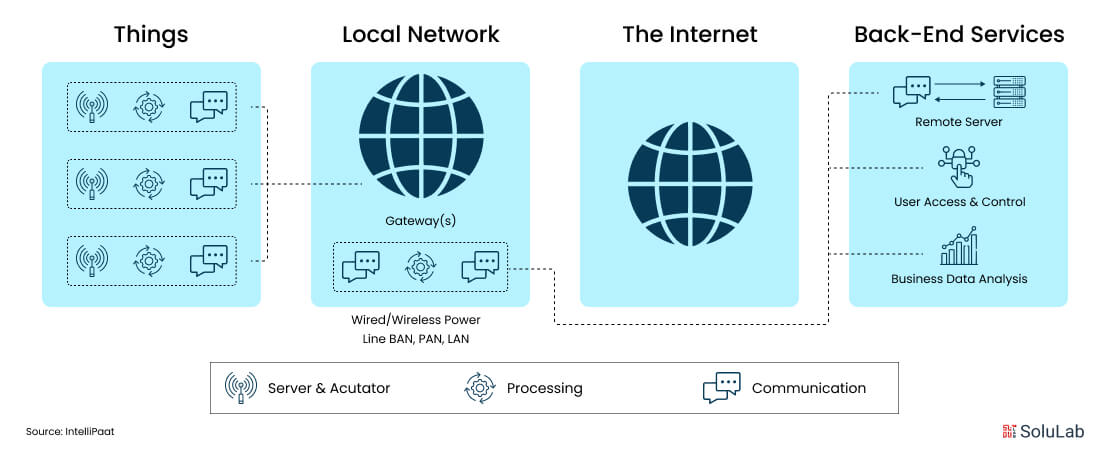
The Internet of Things is an amalgam of user applications, cloud servers, wireless networks, smart gadgets, and the Internet. An IoT device joins a local network. After that, it sends data to the cloud servers over the Internet. Moreover, the cloud servers provide the Internet of Things device access to the data or information from the end-user application. The two-way connection involved in this information transfer is what keeps the Internet of Things running.
As seen in the picture below, an Internet of Things system is made up of four main parts:
- Internet of Things (IoT) Devices: These are intelligent electrical devices with wireless sensors that facilitate data flow across the network.
- Local Network: It facilitates data access from Internet-connected devices.
- The Internet: It facilitates communication between devices, servers and user applications.
- Back-end Services: These comprise mobile applications, a distant server, and user access and control. These services continuously facilitate the exchange of streaming data from different end-user apps and IoT devices.
Benefits of IoT
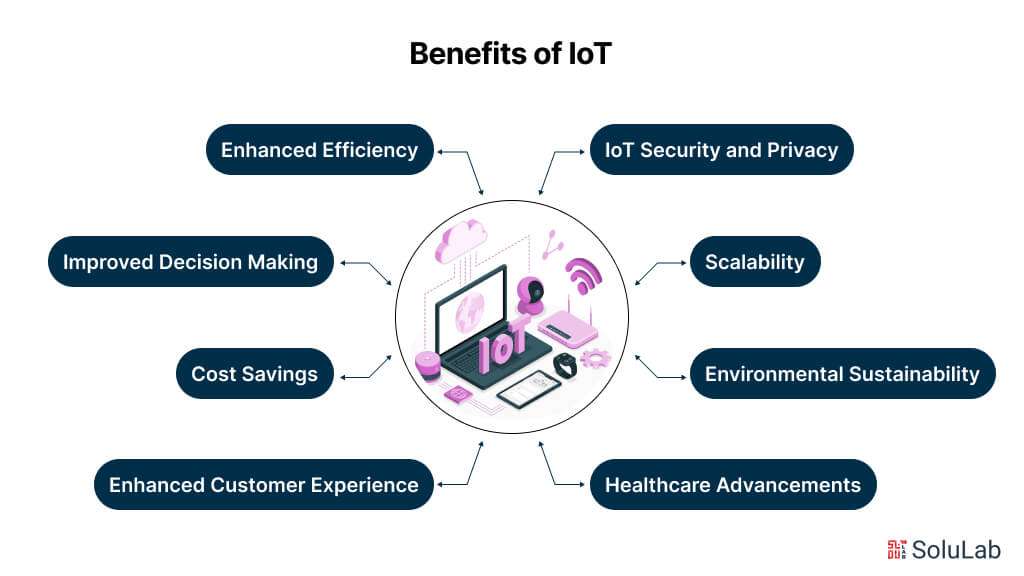
IoT with machine learning brings forth a multitude of benefits, particularly in enhancing efficiency, productivity, and decision-making processes. Here’s a breakdown:
- Enhanced Efficiency: By integrating machine learning in IoT algorithms, businesses can optimize operations and resource utilization. Machine learning can analyze data from IoT sensors to identify patterns and trends, enabling predictive maintenance, efficient inventory management, and streamlined workflows.
- Improved Decision Making: IoT data combined with machine learning algorithms can provide valuable insights in real time. This allows businesses to make data-driven decisions promptly, based on predictive analytics and actionable intelligence derived from the analysis of vast amounts of sensor data.
- Cost Savings: Predictive maintenance enabled by machine learning in IoT can significantly reduce downtime and maintenance costs by detecting potential equipment failures before they occur. This proactive approach prevents costly breakdowns and extends the lifespan of machinery and assets.
- Enhanced Customer Experience: IoT devices can collect valuable data about customer behavior and preferences. By leveraging machine learning algorithms to analyze this data, businesses can personalize products and services, anticipate customer needs, and deliver tailored experiences, thereby increasing customer satisfaction and loyalty.
- IoT Security and Privacy: While IoT introduces security and privacy concerns, machine learning can help mitigate these risks. Machine learning algorithms can detect anomalies in IoT device behavior, identify potential security threats, and proactively respond to cyber attacks. Additionally, encryption techniques and secure authentication methods can be implemented to safeguard IoT data and ensure user privacy.
- Scalability: IoT systems generate vast amounts of data from numerous interconnected devices. Machine learning algorithms can efficiently process and analyze this data at scale, enabling businesses to adapt and scale their IoT infrastructure according to changing requirements and demands.
- Environmental Sustainability: IoT combined with machine learning can contribute to environmental sustainability efforts by optimizing resource consumption, reducing energy wastage, and minimizing carbon footprint. Smart energy management systems, for instance, can analyze IoT data to optimize energy usage in buildings and industrial processes, leading to reduced environmental impact.
- Healthcare Advancements: In healthcare, IoT devices integrated with machine learning algorithms can revolutionize patient care by enabling remote monitoring, early disease detection, and personalized treatment plans. Wearable devices and medical sensors can collect real-time health data, which can be analyzed by machine learning algorithms to provide actionable insights and improve patient outcomes.
Rad Blog: Artificial Intelligence in Healthcare: Future Outlook
Use Cases of IoT
When it comes to IoT, the applications are as diverse as they are transformative. Below, we delve into some of the top IoT applications and glimpse into the future possibilities of this groundbreaking technology.
Top IoT Applications
1. Smart Home Automation: IoT has revolutionized the way we interact with our homes. From thermostats that adjust based on occupancy to smart security systems that provide real-time monitoring, IoT enhances convenience, safety, and energy efficiency in residential spaces.
2. Industrial IoT (IIoT): In manufacturing and industrial settings, IoT plays a pivotal role in optimizing operations. Through sensor-equipped machinery, predictive maintenance analytics, and supply chain monitoring, IIoT enhances productivity, reduces downtime, and facilitates data-driven decision-making.
Read Our Blog: AI Use Cases and Applications in Key Industries
3. Healthcare Monitoring: IoT-enabled medical devices, wearables, and remote patient monitoring systems are transforming healthcare delivery. These technologies facilitate continuous health monitoring, early detection of health issues, and personalized treatment plans, ultimately improving patient outcomes and reducing healthcare costs.
4. Smart Cities: IoT is instrumental in building smarter, more efficient urban environments. From intelligent traffic management systems and smart street lighting to waste management solutions and environmental monitoring, IoT enhances sustainability, reduces congestion, and improves the quality of life in cities.
Future Applications of IoT
Here are some of the IoT future applications to look for:
1. Precision Agriculture: In agriculture, IoT holds the potential to revolutionize farming practices through precision agriculture techniques. By integrating sensors, drones, and data analytics, farmers can monitor crop health, optimize irrigation, and enhance yield while minimizing resource consumption.
2. Autonomous Vehicles: The future of transportation lies in autonomous vehicles, powered by IoT technologies. These vehicles will be equipped with sensors, connectivity, and AI algorithms, enabling them to navigate roads safely, reduce accidents, and optimize traffic flow.
3. Smart Retail: IoT is reshaping the retail landscape, offering personalized shopping experiences and streamlining operations. From inventory management and smart shelves to personalized marketing and cashier-less checkout systems, IoT-driven solutions enhance efficiency and customer satisfaction in retail environments.
Check Out Our Case Studies: IoT in Retail
4. Energy Management: IoT plays a crucial role in optimizing energy usage and promoting sustainability. Smart grids, energy monitoring systems, and demand-response mechanisms enable efficient energy distribution, reduce wastage, and facilitate the integration of renewable energy sources.
Top 10 IoT Trends in 2025
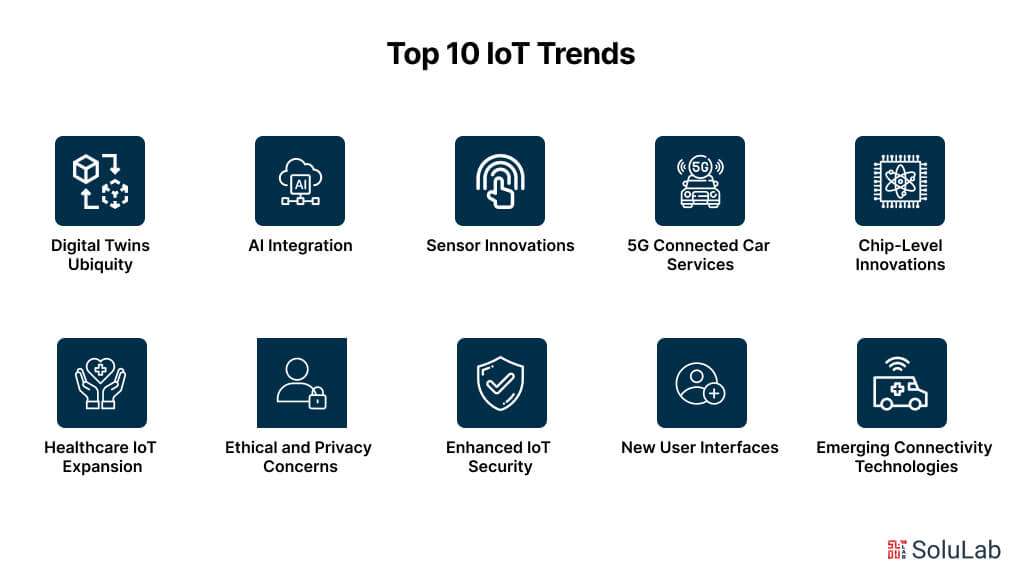
Here are some top trends and predictions for influencers in IoT technology.
1. Digital Twins’ Ubiquity: Digital twins, virtual representations of physical objects or systems, will see widespread adoption across industries in 2025. These digital replicas offer detailed insights into processes, enabling organizations to optimize operations, improve efficiency, and enhance decision-making. Post-COVID-19, businesses are prioritizing supply chain resilience, and digital twins play a crucial role in achieving this by providing visibility and enabling predictive analysis to mitigate disruptions.
2. AI Integration: As IoT devices proliferate, businesses are leveraging the wealth of data generated to power artificial intelligence (AI) models. This integration enables automation of processes, predictive analytics, and enhanced product or service quality. Edge processing capabilities are becoming more prevalent, allowing AI algorithms to run closer to the data source, resulting in faster decision-making and reduced reliance on central processing.
3. Sensor Innovations: Expect continued innovation in sensor technology in 2025, leading to more affordable IoT solutions and improved algorithms for extracting insights from sensor data. Advancements may include higher accuracy, lower power consumption, and increased sensitivity, enabling a wider range of applications across industries such as automotive, agriculture, and healthcare.
4. 5G Connected Car Services: With the global rollout of 5G networks, connected car services will become more prevalent. Enhanced connectivity will enable features such as real-time vehicle-to-vehicle communication, improved Advanced Driver Assistance Systems (ADAS), and seamless integration with other IoT devices. Collaborations between telecom providers and automotive manufacturers will drive the adoption of these services.
5. Chip-Level Innovations: The IoT industry will witness significant advancements at the chip level, driven by the demand for more processing power at the edge and addressing the global chip shortage. Specialized chips optimized for IoT applications will emerge, capable of handling tasks such as neural network processing and AI inference while consuming minimal power. These innovations will accelerate the development of AI-powered IoT solutions.
6. Healthcare IoT Expansion: IoT solutions will continue to transform healthcare, with the market expected to grow significantly by 2025. Smarter wearables and home monitoring devices will become more sophisticated, capable of monitoring various health parameters and facilitating remote patient monitoring. Virtual hospital wards, supported by IoT technology, will enable healthcare professionals to monitor and care for patients remotely, improving accessibility and patient outcomes.
Read Blog: Generative AI in Healthcare
7. Ethical and Privacy Concerns: Increasing awareness of privacy risks associated with IoT devices will drive regulatory actions and consumer demands for enhanced data protection measures. Concerns about data ownership, usage, and security will lead to stricter regulations governing IoT device manufacturers and service providers. Transparency and accountability in data handling practices will become paramount to build trust with consumers.
8. Enhanced IoT Security: The importance of IoT device security will be emphasized further, with governments and consumers demanding robust security features and labeling requirements. Legislation will mandate the removal of default passwords, and IoT devices will be required to undergo security assessments and display security labels indicating their level of protection. Manufacturers will invest in secure-by-design principles and encryption technologies to safeguard IoT ecosystems.
9. New User Interfaces: As IoT devices become more prevalent, manufacturers will explore innovative user interfaces beyond traditional touchscreens. Alternative interaction methods, such as voice commands, gesture recognition, and augmented reality interfaces, will enhance user experiences and improve accessibility. Automotive manufacturers, in particular, will prioritize intuitive interfaces for infotainment systems and vehicle controls.
10. Emerging Connectivity Technologies: The adoption of new connectivity technologies, such as Narrowband IoT (NBIoT) and advancements in 5G and satellite internet, will enable new AI applications and use cases. These technologies offer improved coverage, lower latency, and increased bandwidth, facilitating reliable communication between IoT devices and cloud platforms. OEMs will leverage these connectivity options to develop innovative IoT products tailored to specific industry needs.
Future of IoT
The future of Internet of Things is exciting & dynamic. One of the main elements of the enormous change the world is undergoing is the Internet of Things (IoT). It seems certain that a variety of modern technologies, including edge computing, 5G, AI, and machine learning, will form the foundation of the future. Future projections for the Internet of Things include that it will completely transform sectors like industry, logistics, transportation, healthcare, and agriculture.
1. IoT Device Growth Projection
The forecast of over 21 billion IoT devices by 2025 represents a significant expansion from the 4.7 billion devices in 2016 and nearly 11.6 billion devices in 2021. This trajectory underscores the widespread integration of IoT technologies across diverse sectors, including smart homes, healthcare, manufacturing, and more.
2. Cyber Threats and IoT Vulnerabilities
The emergence of cyber threats targeting IoT devices is exemplified by the Mirai malware incident of 2016. Exploiting default credentials, this malware hijacked IoT devices to orchestrate Distributed Denial of Service (DDoS) attacks, disrupting critical services and websites. Such incidents highlight the inherent vulnerabilities within IoT ecosystems and the importance of robust security measures.
3. Adoption of Smart Technologies in Cities and Enterprises
Cities and enterprises are increasingly leveraging IoT technologies to enhance efficiency, sustainability, and resource management. Through the deployment of sensors and connected devices, cities can optimize services such as transportation, waste management, energy consumption, and public safety. Similarly, enterprises benefit from IoT solutions for process automation, supply chain optimization, and asset tracking, driving operational efficiency and cost savings.
4. Convergence of AI and IoT
The convergence of artificial intelligence (AI) and IoT enables transformative capabilities in user experiences and device functionality. By harnessing data collected from IoT sensors, AI algorithms can personalize interactions, anticipate user preferences, and optimize device performance. This integration facilitates intelligent automation, predictive analytics, and adaptive decision-making within IoT ecosystems.
5. Role of Routers in IoT Security
Routers play a crucial role in safeguarding IoT networks by serving as gateways between devices and the internet. Implementing robust security measures such as firewall protection, intrusion detection, and access control, routers mitigate cyber threats targeting vulnerable endpoints. As the number of IoT devices proliferates, routers become indispensable components in ensuring network security and resilience.
6. Impact of 5G Networks on IoT Adoption
The rollout of 5G networks accelerates the adoption of IoT solutions by enabling faster data transfer, lower latency, and increased device density. This advancement unlocks new opportunities for innovative applications across industries, including autonomous vehicles, remote healthcare monitoring, smart infrastructure management, and immersive multimedia experiences.
Conclusion
The world is moving toward a more automated, linked digital setting, which means there is never been a better opportunity for IoT development and innovation in the future. IoT devices are already providing countless opportunities for data collection and the emergence of new applications in daily life.
As usual, these developments will bring with them difficulties, such as threats to privacy and security. By now, businesses ought to have a solid plan in place to optimize their influence across the various IoT value chain domains. Government programs that encourage technical development and investments in networked infrastructure make it inevitable that the Internet of Things will take over our lives in the future.
SoluLab, a leading IoT development company enables organizations to fully realize the promise of IoT technology for driving innovation and digital transformation. SoluLab, with its team of experienced IoT developers and engineers, specializes in designing bespoke IoT solutions that are suited to each client’s specific requirements. SoluLab helped Gearnetics develop an advanced IoT fleet management solution, enabling real-time monitoring for 10,000+ vehicles. Built on AWS IoT, it eliminated outdated onboard scales, offering route tracking, driver monitoring, fuel analysis, and weight management. With secure data transmission and real-time updates, the company saw a 47% ROI increase, optimizing 2,000+ trucks with smart sensors. SoluLab to get started with your IoT journey today. Contact SoluLab to get started with your IoT journey today.
FAQs
1. What is IoT, and how does it work?
IoT, or the Internet of Things, refers to the network of interconnected devices embedded with sensors, software, and other technologies that enable them to collect and exchange data over the Internet. These devices can range from smartphones and wearable gadgets to industrial machines and smart home appliances. IoT works by gathering data from these devices, analyzing it in real time, and using insights to automate processes, improve efficiency, and enhance user experiences.
2. What are the benefits of IoT adoption for businesses?
IoT adoption offers numerous benefits for businesses, including increased operational efficiency, cost savings through predictive maintenance, enhanced customer experiences through personalized services, and improved decision-making with real-time data insights. Additionally, IoT enables businesses to unlock new revenue streams, drive innovation, and gain a competitive edge in today’s digital economy.
3. What are some examples of IoT applications across industries?
IoT technology finds applications across various industries, such as healthcare, agriculture, manufacturing, smart cities, and transportation. For instance, in healthcare, IoT devices like wearable fitness trackers and remote patient monitoring systems help track vital signs and manage chronic conditions. In agriculture, IoT sensors monitor soil moisture levels and automate irrigation systems to optimize crop yields. Similarly, in manufacturing, IoT-enabled predictive maintenance reduces downtime and extends equipment lifespan.
4. What are the security and privacy concerns associated with IoT?
While IoT offers numerous benefits, it also raises concerns about security and privacy. IoT devices are vulnerable to cyber attacks, data breaches, and unauthorized access if not adequately secured. Additionally, the collection and storage of sensitive data by IoT devices raise privacy concerns regarding data ownership, consent, and usage. To address these challenges, businesses must implement robust security measures, encryption protocols, and privacy policies to safeguard IoT ecosystems and user data.
5. How can businesses get started with IoT adoption?
Getting started with IoT adoption involves several steps, including defining clear business objectives, identifying use cases aligned with organizational goals, selecting suitable IoT platforms and technologies, and partnering with experienced IoT development companies for implementation. It’s essential to conduct thorough research, assess technology requirements, and develop a roadmap for successful IoT deployment. By taking a strategic approach and leveraging the expertise of IoT professionals, businesses can embark on their IoT journey with confidence and maximize the benefits of this transformative technology.
6. How can SoluLab assist businesses in IoT development?
SoluLab is a trusted IoT development company known for its expertise in crafting tailored IoT solutions to meet the unique needs of businesses across various industries. With a dedicated team of skilled AI developers and engineers, SoluLab offers end-to-end IoT development services, from initial consultation and ideation to prototyping, implementation, and ongoing support. By leveraging modern technologies and best practices in IoT architecture, SoluLab helps businesses harness the full potential of IoT to drive innovation, streamline operations, and enhance customer experiences. With a proven track record of delivering successful IoT projects, SoluLab is committed to empowering businesses to thrive in the connected world of tomorrow.



